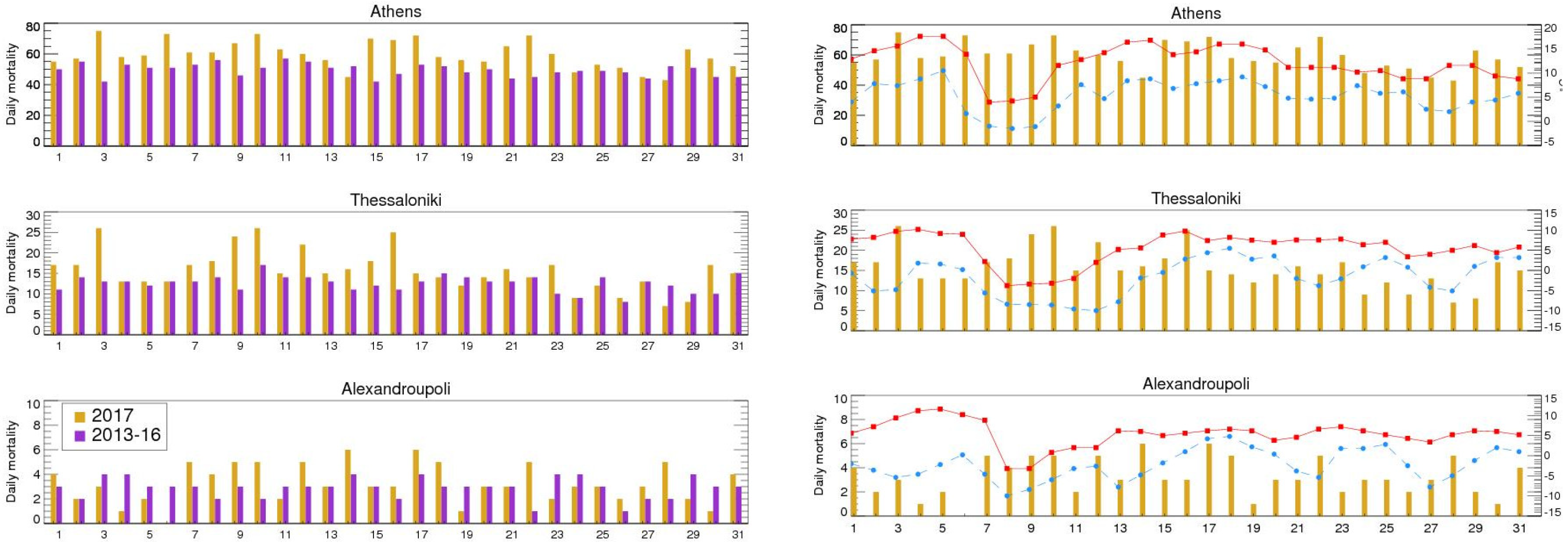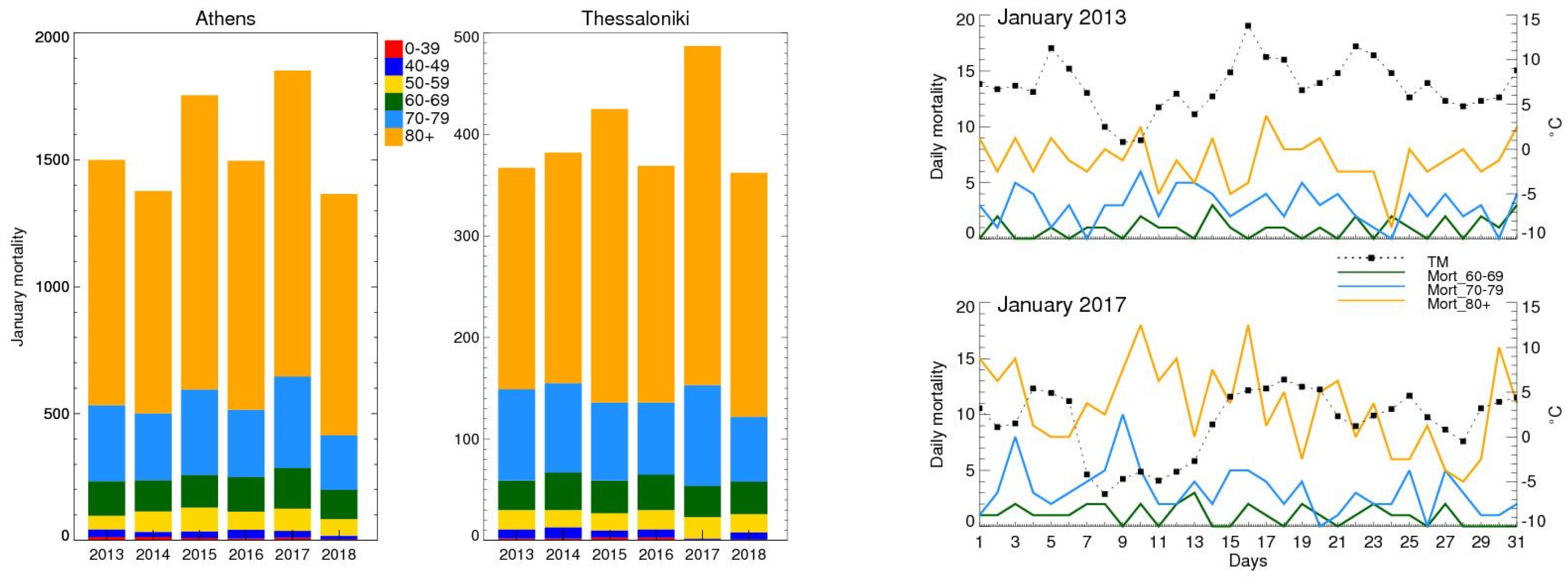Analysis of the January 2017 Cold Spell in Greece and Its Implications on Human Health †
Abstract
:1. Introduction
2. Materials and Methods
3. Results
3.1. Analysis of Meteorological Data
3.1.1. Upper Atmospheric Conditions
3.1.2. Surface Air Temperature Analysis
3.2. Analysis of Mortality Data
4. Conclusions
Funding
Institutional Review Board Statement
Informed Consent Statement
Data Availability Statement
Conflicts of Interest
References
- Ring, M.J.; Plumb, R.A. Forced annular mode patterns in a simple atmospheric general circulation model. J. Atmos. Sci. 2007, 64, 3611–3626. [Google Scholar] [CrossRef]
- Coppola, E.; Kucharski, F.; Giorgi, F.; Molteni, F. Bimodality of the North Atlantic Oscillation in simulations with greenhouse gas forcing. Geophys. Res. Lett. 2005, 32, 23709. [Google Scholar] [CrossRef]
- Scaife, A.A.; Folland, C.K.; Alexander, L.V.; Moberg, A.; Knight, J.R. European climate extremes and the North Atlantic Oscillation. J. Clim. 2008, 21, 72–83. [Google Scholar] [CrossRef]
- Brunner, L.; Hegerl, G.C.; Steiner, A.K. Connecting atmospheric blocking to European temperature extremes in spring. J. Clim. 2017, 30, 585–594. [Google Scholar] [CrossRef]
- García-Herrera, R.; Díaz, J.; Trigo, R.M.; Luterbacher, J.; Fischer, E.M. A Review of the European Summer Heat Wave of 2003. Crit. Rev. Environ. Sci. Technol. 2010, 40, 267–306. [Google Scholar] [CrossRef]
- Katsafados, P.; Papadopoulos, A.; Varlas, G.; Papadopoulou, E.; Mavromatidis, E. Seasonal predictability of the 2010 Russian heat wave. Nat. Hazards Earth Syst. Sci. 2014, 14, 1531–1542. [Google Scholar] [CrossRef]
- Cattiaux, J.; Vautard, R.; Cassou, C.; Yiou, P.; Masson-Delmotte, V.; Codron, F. Winter 2010 in Europe: A cold extreme in a warmingclimate. Geophys. Res. Lett. 2010, 37, 20704. [Google Scholar]
- Cohen, J.; Foster, J.; Barlow, M.; Saito, K.; Jones, J. Winter 2009–2010: A case study of an extreme Arctic Oscillation event. Geophys. Res. Lett. 2010, 37, 17707. [Google Scholar] [CrossRef]
- Hartley, S.; Keables, M.J. Synoptic Associations of Winter Climate and Snowfall Variability in New England, USA, 1950–1992. Int. J. Climatol. 1998, 18, 281–298. [Google Scholar] [CrossRef]
- Hall, R.; Erdélyi, R.; Hanna, E.; Jones, J.; Scaife, A. Drivers of North Atlantic Polar Front jet stream variability. Int. J. Climatol. 2014, 35, 1697–1720. [Google Scholar] [CrossRef]
- Kysely, J.; Pokorna, L.; Kyncl, J.; Kriz, B. Excess cardiovascular mortality associated with cold spells in the Czech Republic. BMC Public Health 2009, 9, 19. [Google Scholar] [CrossRef]
- Rocklöv, J.; Forsberg, B.; Ebi, K.; Bellander, T. Susceptibility to mortality related to temperature and heat and cold wave duration in the population of Stockholm County, Sweden. Glob. Health Action 2014, 7, 22737. [Google Scholar] [CrossRef]
- Xie, H.; Yao, Z.; Zhang, Y.; Xu, Y.; Xu, X.; Liu, T.; Lin, H.; Lao, X.; Rutherford, S.; Chu, C.; et al. Short-term effects of the 2008 cold spell on mortality in three subtropical cities in Guangdong Province, China. Environ. Health Perspect. 2013, 121, 210–216. [Google Scholar] [CrossRef]
- Moghadamnia, M.T.; Ardalan, A.; Mesdaghinia, A.; Keshtkar, A.; Naddafi, K.; Yekaninejad, M.S. Ambient temperature and cardiovascular mortality: A systematic review and meta-analysis. PeerJ 2017, 5, 3574. [Google Scholar] [CrossRef] [PubMed]
- Anagnostopoulou, C.; Tolika, K.; Lazoglou, G.; Maheras, P. The Exceptionally Cold January of 2017 over the Balkan Peninsula: A Climatological and Synoptic Analysis. Atmosphere 2017, 8, 252. [Google Scholar] [CrossRef]
- Tringa, Ε.; Tolika, K.; Anagnostopoulou, C.; Kostopoulou, Ε. A Climatological and Synoptic Analysis of Winter Cold Spells over the Balkan Peninsula. Atmosphere 2022, 13, 1851. [Google Scholar] [CrossRef]
- Ogimet. Available online: http://www.ogimet.com (accessed on 1 April 2023).
- WMO. Available online: https://public.wmo.int/en/media/news/siberian-cold-hits-southeastern-europe (accessed on 1 April 2023).





| Athens | Thessaloniki | Alexandroupoli | |
|---|---|---|---|
| TX | 12.1 (14.1) | 5.5 (10.0) | 5.4 (9.7) |
| TN | 5.2 (7.0) | −1.5 (2.5) | −2.3 (2.0) |
| TM | 8.0 (10.1) | 1.6 (5.9) | 2.0 (5.4) |
Disclaimer/Publisher’s Note: The statements, opinions and data contained in all publications are solely those of the individual author(s) and contributor(s) and not of MDPI and/or the editor(s). MDPI and/or the editor(s) disclaim responsibility for any injury to people or property resulting from any ideas, methods, instructions or products referred to in the content. |
© 2023 by the author. Licensee MDPI, Basel, Switzerland. This article is an open access article distributed under the terms and conditions of the Creative Commons Attribution (CC BY) license (https://creativecommons.org/licenses/by/4.0/).
Share and Cite
Kostopoulou, E. Analysis of the January 2017 Cold Spell in Greece and Its Implications on Human Health. Environ. Sci. Proc. 2023, 26, 195. https://doi.org/10.3390/environsciproc2023026195
Kostopoulou E. Analysis of the January 2017 Cold Spell in Greece and Its Implications on Human Health. Environmental Sciences Proceedings. 2023; 26(1):195. https://doi.org/10.3390/environsciproc2023026195
Chicago/Turabian StyleKostopoulou, Effie. 2023. "Analysis of the January 2017 Cold Spell in Greece and Its Implications on Human Health" Environmental Sciences Proceedings 26, no. 1: 195. https://doi.org/10.3390/environsciproc2023026195
APA StyleKostopoulou, E. (2023). Analysis of the January 2017 Cold Spell in Greece and Its Implications on Human Health. Environmental Sciences Proceedings, 26(1), 195. https://doi.org/10.3390/environsciproc2023026195






